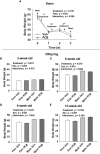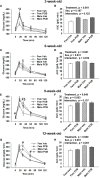Exposure to PCB126 during the nursing period reversibly impacts early-life glucose tolerance
- PMID: 37033268
- PMCID: PMC10073482
- DOI: 10.3389/fendo.2023.1085958
Exposure to PCB126 during the nursing period reversibly impacts early-life glucose tolerance
Abstract
Polychlorinated biphenyls (PCBs) are persistent environmental organic pollutants known to have detrimental health effects. Using a mouse model, we previously demonstrated that PCB126 exposure before and during pregnancy and throughout the perinatal period adversely affected offspring glucose tolerance and/or body composition profiles. The purpose of this study was to investigate the glucose tolerance and body composition of offspring born to dams exposed to PCB126 during the nursing period only. Female ICR mice were bred, and half of the dams were exposed to either vehicle (safflower oil) or 1 µmole PCB126 per kg of body weight via oral gavage on postnatal days (PND) 3, 10, and 17 (n = 9 per group). Offspring body weight, lean and fat mass, and glucose tolerance were recorded every three weeks. PCB126 treatment did not alter dam nor offspring body weight (p > 0.05). PCB126-exposed male and female offspring displayed normal body composition (p > 0.05) relative to vehicle-exposed offspring. However, both male and female offspring that were exposed to PCB126 during the nursing period had significantly impaired glucose tolerance at 3 and 9 weeks of age (p < 0.05). At 6 and 12 weeks of age, no impairments in glucose tolerance existed in offspring (p > 0.05). Our current study demonstrates that exposure to PCB126 through the mother's milk does not affect short- or long-term body composition but impairs glucose tolerance in the short-term.
Keywords: DOHaD (development origins of health and disease); developmental programming of adult disease; diabetes; lactation; mice; obesity; polychlorinated biophenyls.
Copyright © 2023 Rice, Sammons, Ngo Tenlep, Weltzer, Reynolds, Rashid, Swanson and Pearson.
Conflict of interest statement
The authors declare that the research was conducted in the absence of any commercial or financial relationships that could be construed as a potential conflict of interest.
Figures



Similar articles
-
Lack of Offspring Nrf2 Does Not Exacerbate the Detrimental Metabolic Outcomes Caused by In Utero PCB126 Exposure.Front Endocrinol (Lausanne). 2021 Dec 16;12:777831. doi: 10.3389/fendo.2021.777831. eCollection 2021. Front Endocrinol (Lausanne). 2021. PMID: 34975753 Free PMC article.
-
Prenatal exposure to 3,3',4,4',5-pentachlorobiphenyl (PCB126) promotes anxiogenic behavior in rats.Tohoku J Exp Med. 2007 Jun;212(2):151-7. doi: 10.1620/tjem.212.151. Tohoku J Exp Med. 2007. PMID: 17548959
-
Responsiveness of hepatic and cerebral cytochrome P450 in rat offspring prenatally and lactationally exposed to a reconstituted PCB mixture.Environ Toxicol. 2014 Aug;29(8):856-66. doi: 10.1002/tox.21812. Epub 2012 Sep 15. Environ Toxicol. 2014. PMID: 22987612
-
Environmental exposure to polychlorinated biphenyls (PCBs) and dioxins. Consequences for longterm neurological and cognitive development of the child lactation.Adv Exp Med Biol. 2000;478:271-87. Adv Exp Med Biol. 2000. PMID: 11065080 Review.
-
Offspring body size and metabolic profile - effects of lifestyle intervention in obese pregnant women.Dan Med J. 2014 Jul;61(7):B4893. Dan Med J. 2014. PMID: 25123127 Review.
References
-
- Bacon CE, Jarman WM, Costa DP. Organochlorine and polychlorinated biphenyl levels in pinniped milk from the Arctic, the Antarctic, California and Australia. Chemosphere (1992) 24(6):779–91. doi: 10.1016/0045-6535(92)90538-3 - DOI
Publication types
MeSH terms
Substances
Grants and funding
LinkOut - more resources
Full Text Sources

